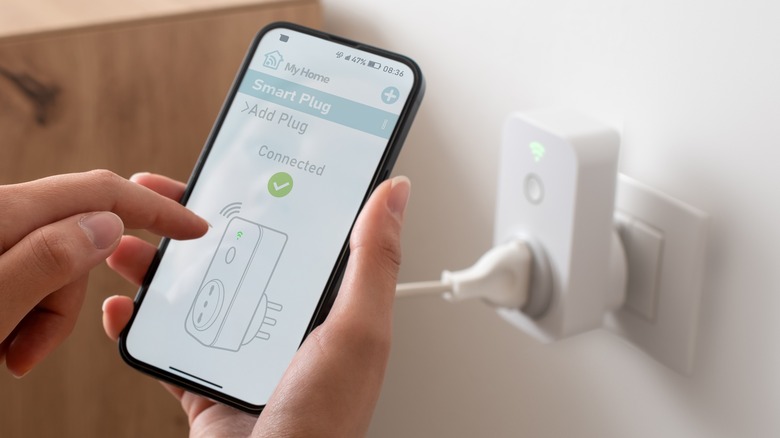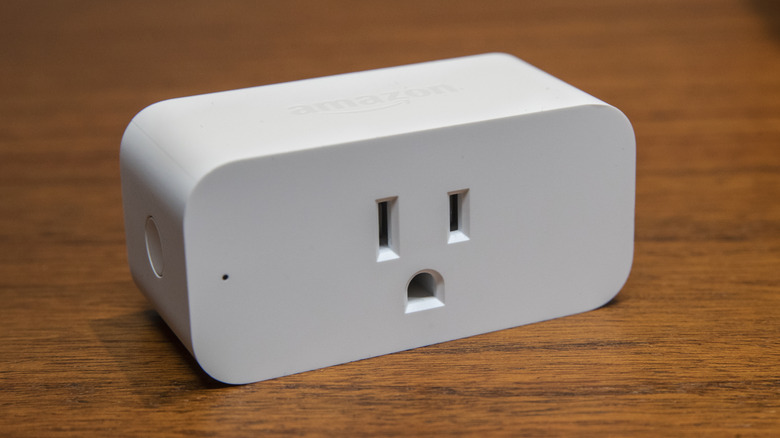Picking The Right Smart Plugs Matters, Here's Why
We may receive a commission on purchases made from links.
For convenience, security, and energy savings, it seems like there's a smart version of just about anything that uses electricity, from coffee makers to decorative lighting. But perhaps you're trying to create a smart home on a budget. Or maybe you're emotionally attached to your existing stuff? Smart plugs have got you covered. If you're able to download an app, then you're able to use a smart plug, which turns any device into a smart device via remote switching that's controlled by Wi-Fi. But with a seemingly endless selection of smart plugs on the market, how do you know where to get started?
First and foremost, you need to choose a smart plug that supports your preferred smart home platform and can optionally be paired with a voice assistant such as Siri (Apple HomeKit), Google Assistant (Google Home), or Alexa (Amazon Alexa). Some smart plugs are compatible with multiple or all smart home ecosystems, while others only support a single smart home platform. Currently, Google and Alexa have the largest number of compatible products, while Apple users will find themselves with fewer choices.
Smart plug size matters
The majority of smart plugs are compact in size and will only occupy half of a typical North American duplex outlet — the top or bottom plug — allowing the other plug in the duplex outlet to function normally with continuous power. However, certain smart plugs are larger and will occupy an entire duplex outlet, preventing anything else from being plugged in — a concern if no other outlets are located nearby. A handy feature that's present in some smart plugs is a switch on the plug's body that turns the current on and off manually, without the need for a smartphone or voice assistant nearby.
Another type of smart plug takes the form of a conventional power strip, with two or more receptacles and a short extension cord that plugs into the wall outlet. Many of the smart power strips allow independent control of the strip's individual outlets and can even double as surge protectors. Lastly, if you're planning to use a smart plug outdoors, make sure that it's weatherproof and rated for a wider temperature range. Fortunately, most smart plugs for outdoor use are clearly labeled as such.
Smart plugs can kill energy suckers
Once compatibility and size constraints have been determined, it's time to consider features. Energy monitoring can be an important step in lowering power bills. Smart plugs that are able to monitor consumption, typically daily, weekly, or monthly, will display the information on the smart plug's app.
Many consumers are surprised to learn that electronics still draw power even after being turned off, referred to as standby mode. Chargers for phones, laptops, and tablets that are perpetually plugged in can also waste energy.
According to the Department of Energy, these so-called "energy vampires" can add up to an extra $100-200 per year in utility bills. A smart plug with energy monitoring can identify the degree of energy-sucking that's occurring and allow users to set the offending devices on a timer, powering them down during the night, for example.
Speaking of timers, smart plugs have varying degrees of scheduling functionality which should be considered when making a purchase. Some plugs can schedule an appliance to turn on or off automatically each day or adjust the routine based on a particular day of the week. For example, if you sleep later on weekends, a coffeemaker can be scheduled to turn on later during those days.
A byproduct of scheduling is a function called "away mode" or similar, which turns lights and perhaps entertainment devices on randomly to simulate an occupied home, so burglars or other ne'er-do-well types won't realize that you're away on vacation.
Smart consumers will consider purchasing a multi-pack of smart plugs because like many other items, buying in bulk can save money. For example, this highly-rated four-pack from Govee sells for under $30.


